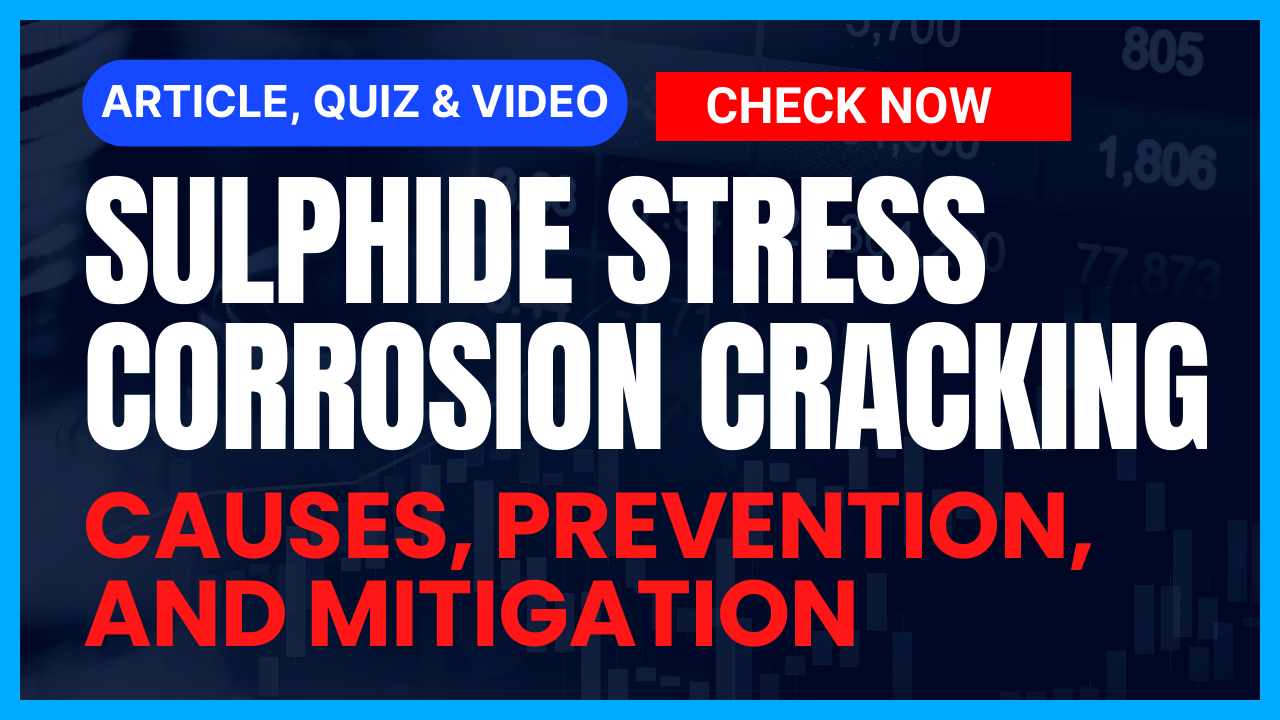Introduction
Among various forms of corrosion, Sulphide Stress Corrosion Cracking (SSCC) stands out as a particularly insidious and destructive mechanism. Corrosion is a significant concern in the oil, gas, and petrochemical industries due to its potential to cause catastrophic failures and economic losses. In this comprehensive guide, we delve into the causes, prevention strategies, and remediation techniques for Sulphide Stress Corrosion Cracking in piping systems.
Table of Contents
Understanding Sulphide Stress Corrosion Cracking
Causes of Sulphide Stress Corrosion Cracking
Sulphide Stress Corrosion Cracking primarily occurs in materials exposed to environments containing hydrogen sulphide (H2S). The cracking mechanism is a result of the combined effect of tensile stress, susceptible material, and the presence of hydrogen sulphide. The hydrogen embrittlement mechanism exacerbates the cracking process.
Don’t miss the Complete Course on Piping Engineering: Check Now
By EPCLand.com
Factors Contributing to SSCC
- Tensile Stress: Residual or applied tensile stress, often from operational conditions or improper installation, plays a pivotal role in initiating and propagating cracks.
- Material Susceptibility: High-strength steels with hardness above a certain threshold are more susceptible to SSCC. Alloy composition, microstructure, and heat treatment also influence susceptibility.
- Hydrogen Sulphide Concentration: Higher concentrations of H2S in the environment increase the likelihood of SSCC. Sour environments, prevalent in the oil and gas industry, pose a significant threat.
Prevention Strategies
Material Selection
Choosing the right material is paramount in preventing SSCC. Austenitic stainless steels, duplex stainless steels, and nickel-based alloys exhibit superior resistance to SSCC in H2S environments.
Environmental Control
Minimizing exposure to hydrogen sulphide is a key preventive measure. Implementing proper ventilation, using corrosion inhibitors, and maintaining appropriate pH levels can reduce the risk of SSCC.
Stress Management
Mitigating tensile stress through proper design, installation, and operational practices is crucial. Stress-relief annealing and post-weld heat treatment can alleviate stress and enhance material resistance.
Cathodic Protection
Employing cathodic protection techniques, such as sacrificial anodes or impressed current systems, can create a protective electrochemical environment that hinders SSCC.
Regular Inspection and Monitoring
Frequent inspections, non-destructive testing, and monitoring of critical piping systems can help detect early signs of cracking and prevent catastrophic failures.
Remediation Techniques
Weld Overlay
Applying a corrosion-resistant alloy overlay through welding can remediate existing SSCC and provide added protection against future cracking.
Corrosion Inhibitors
Injecting corrosion inhibitors can slow down or arrest the corrosion process, buying time for more comprehensive remediation.
Mechanical Patching
For localized SSCC, mechanical patches can be installed to reinforce the affected areas and prevent crack propagation.
Stress Relief
Post-weld heat treatment or stress-relief annealing can alleviate residual stresses, reducing the risk of further cracking.
Pipe Replacement
In severe cases, replacing the affected piping with more corrosion-resistant materials is the most effective solution.
FAQs (Frequently Asked Questions)
FAQ 1: What is Sulphide Stress Corrosion Cracking? Sulphide Stress Corrosion Cracking is a form of corrosion that occurs in materials exposed to hydrogen sulphide environments, leading to cracking and potential failures.
FAQ 2: How does tensile stress contribute to SSCC? Tensile stress, whether residual or applied, weakens the material’s resistance and can initiate and propagate cracks in the presence of hydrogen sulphide.
FAQ 3: Are certain materials more resistant to SSCC? Yes, materials like austenitic stainless steels, duplex stainless steels, and nickel-based alloys are known for their superior resistance to SSCC in H2S environments.
FAQ 4: Can SSCC be prevented entirely? While complete prevention is challenging, implementing proper material selection, environmental control, stress management, and regular inspections can significantly reduce the risk of SSCC.
FAQ 5: What should be done if SSCC is detected? Upon detection of SSCC, actions such as weld overlay, corrosion inhibitors, stress relief, mechanical patching, and even pipe replacement can be taken depending on the severity of the cracking.
Don’t miss the Complete Course on Piping Engineering: Check Now
By EPCLand.com
Conclusion
Sulphide Stress Corrosion Cracking poses a significant threat to piping systems in industries where hydrogen sulphide exposure is prevalent. Understanding its causes, prevention strategies, and remediation techniques is essential for safeguarding infrastructure and preventing potentially catastrophic failures. By implementing a holistic approach that includes material selection, stress management, and regular monitoring, industries can effectively mitigate the risks associated with SSCC and ensure the long-term integrity of their piping systems.
Recommended courses (Published on EPCLand)
- Basics of Piping Engineering
- Piping Layout Engineering
- Piping Material Engineering
- Piping Stress Analysis
- Complete Course on Piping Engineering
- Material Requisitions
- Piping Material Specifications
- Valve Material Specifications
Don’t miss the published articles on following:
Related Video
Attempt Quiz
Question 1:
What is Sulphide Stress Corrosion Cracking (SSC) in piping?
Explanation: Sulphide Stress Corrosion Cracking (SSC) is a type of corrosion that occurs in the presence of hydrogen sulphide (H2S) gas and tensile stress in susceptible materials, often affecting pipelines and equipment in the oil and gas industry.
Question 2:
Which material is particularly susceptible to Sulphide Stress Corrosion Cracking?
Explanation: Carbon steel is particularly susceptible to Sulphide Stress Corrosion Cracking due to its susceptibility to hydrogen embrittlement in the presence of hydrogen sulphide and tensile stress.
Question 3:
What are common measures to mitigate Sulphide Stress Corrosion Cracking?
Explanation: Common measures to mitigate Sulphide Stress Corrosion Cracking include reducing the temperature and hydrogen sulphide concentration, using resistant materials, and applying protective coatings to prevent direct contact with corrosive environments.
Question 4:
Which industry is most commonly affected by Sulphide Stress Corrosion Cracking in piping?
Explanation: The oil and gas industry is most commonly affected by Sulphide Stress Corrosion Cracking in piping due to the presence of hydrogen sulphide in oil and gas reservoirs and transportation pipelines.
Question 5:
What is the role of tensile stress in the development of Sulphide Stress Corrosion Cracking?
Explanation: Tensile stress promotes the initiation and propagation of cracks in the presence of hydrogen sulphide, leading to the development of Sulphide Stress Corrosion Cracking. Tensile stress accelerates the corrosion process in susceptible materials.
